BUICK CENTURY 1993 Owners Manual
Manufacturer: BUICK, Model Year: 1993, Model line: CENTURY, Model: BUICK CENTURY 1993Pages: 324, PDF Size: 17.58 MB
Page 191 of 324
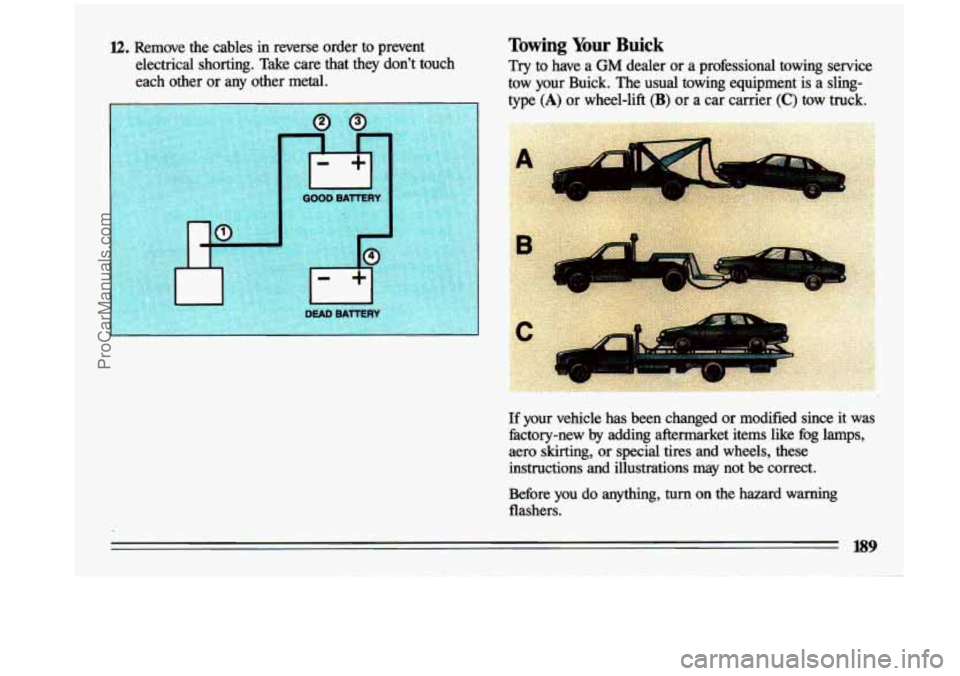
12. Remove the cables in reverse order to prevent
electrical shorting. Take care that they don't touch
each other or any other metal. Towing Your Buick
Try to have a GM dealer or a professional towing service
tow your Buick. The usual towing equipment is
a sling-
tvPe (A) or wheel-lift (B) or a car carrier (C) tow truck.
If your vehicle has been changed or modified since it was
fhctory-new by adding aftermarket items
like fog lamps,
aero skirting, or special tires and wheels, these
instructions and illustrations may not be correct.
Before
you do anything, turn on the hazard warning
flashers.
189
ProCarManuals.com
Page 192 of 324
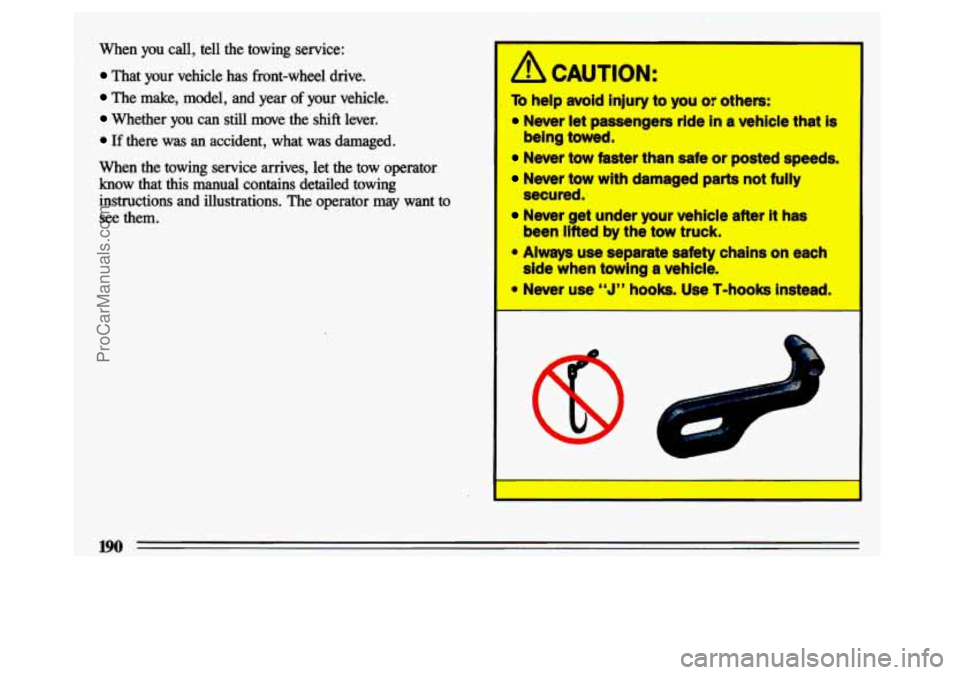
When you call, tell the towing service:
That your vehicle has front-wheel drive.
The make, model, and year of your vehicle.
Whether you can still move the shift lever.
If there was an accident, what was damaged.
When the towing service arrives, let the tow operator
know that
this manual contains detailed towing
instructions and illustrations. The operator
may want to
see them.
-
/i CAUTION:
. To help avoid injury to you or othem:
Never let passengers rlde In a vehlcle that is
Never tow faster than safe or posted speeds.
Never tow with damaged parts not fully
Never get under your vehicle after it has
0 Always use separate safety chalns on each
@ Never use “J” hooks. Use T-hooks Instead.
being towed.
Secured:
been lifted by the tow truck.
side when towing
a vehlcle.
ProCarManuals.com
Page 193 of 324
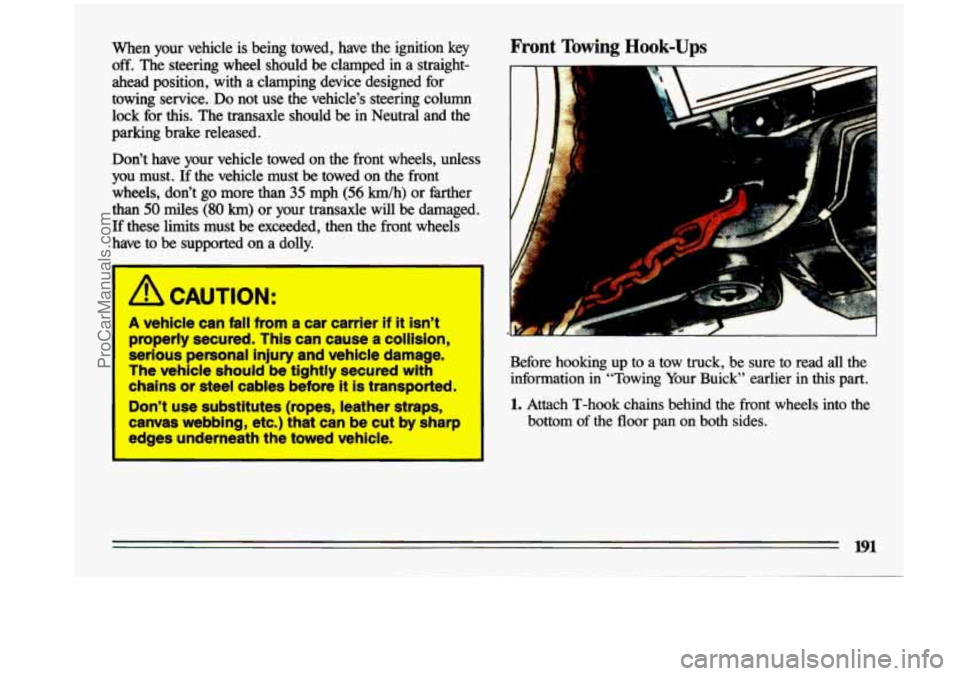
when your vehicle is being towed, have the ignition key Front Towing Hook-Ups
off. The steering wheel should be clamped in a straight-
ahead position, with a clamping device designed for
towing service.
Do not use the vehicle’s steering column
lock for
this. The transaxle should be in Neutral and the
parking brake released.
I
Don’t have your vehicle towed on the front wheels, unless
you must. If the vehicle must be towed on the front
wheels, don’t go more than
35 mph (56 km/h) or farther
than
50 miles (80 km) or your transaxle will be damaged.
If these limits must be exceeded, then the front wheels
have
to be supported on a dolly.
1
I
&!, CAUTION:
A vehicle can fall from a car carrier if It Isn’t
properly secured.
This can cause a colllsion,
serious personal injury and vehicle damage.
The vehicle should be tightly secured with Before hooking up to a tow truck, be sure to read all the
chains or steel cables before it is transported. information in “Towing Your Buick” earlier in this part.
Don’t use substitutes (ropes, leather straps, I
1. Attach T-hook chains behind the front wheels into the
canvas webbing, etc.) that can be cut by sharp bottom of the floor pan on both sides.
edges underneath the towed vehicle. I
191
ProCarManuals.com
Page 194 of 324
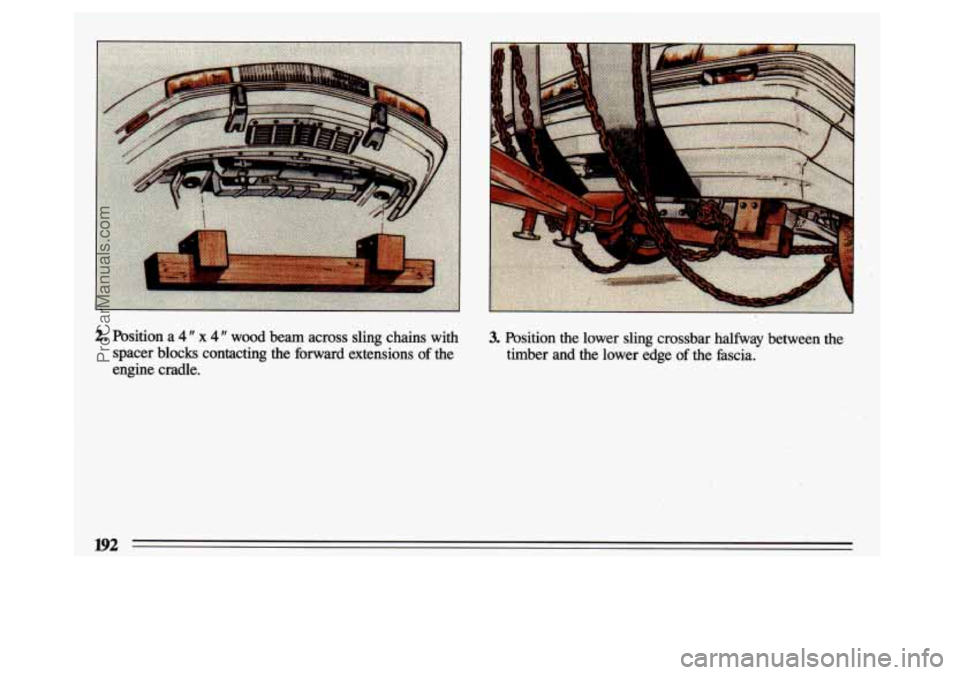
2. Position a 4 I' x 4 I' wood beam across sling chains with
spacer blocks contacting the forward extensions
of the
engine cradle.
3. Position the lower sling crossbar halfway between the
timber
and the lower edge of the fascia.
192
ProCarManuals.com
Page 195 of 324
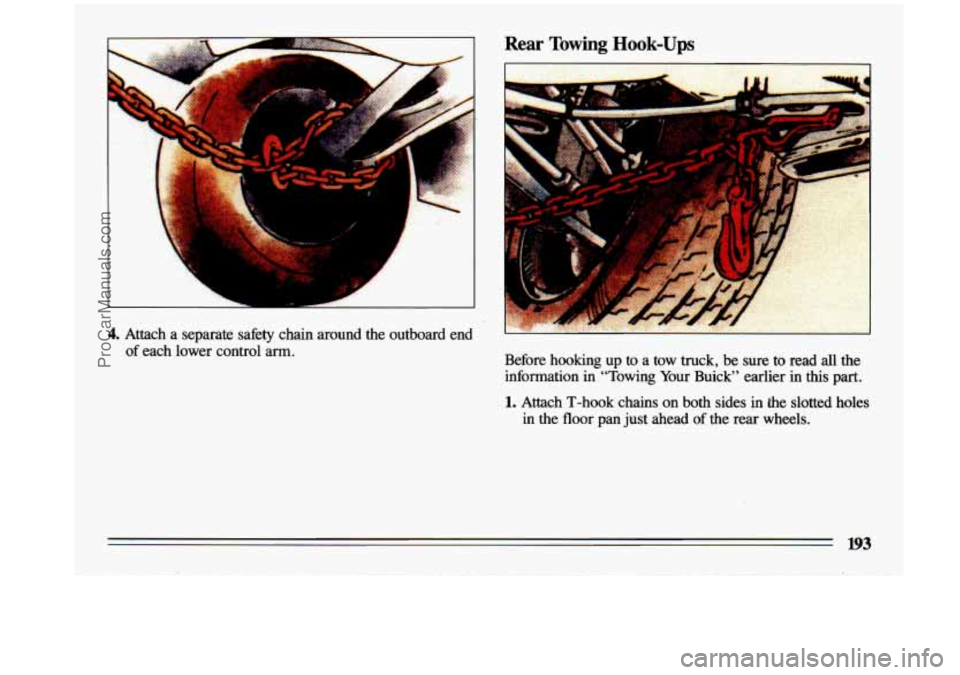
I
1;
4. Attach a separate safety chain around the outboard end
of each lower control arm. Before hooking up
to a tow truck, be sure to read all the
information in “Towing Your Buick” earlier in this part.
1. Attach T-hook chains on both sides in the slotted holes
in the
floor pan just ahead of the rear wheels.
193
ProCarManuals.com
Page 196 of 324
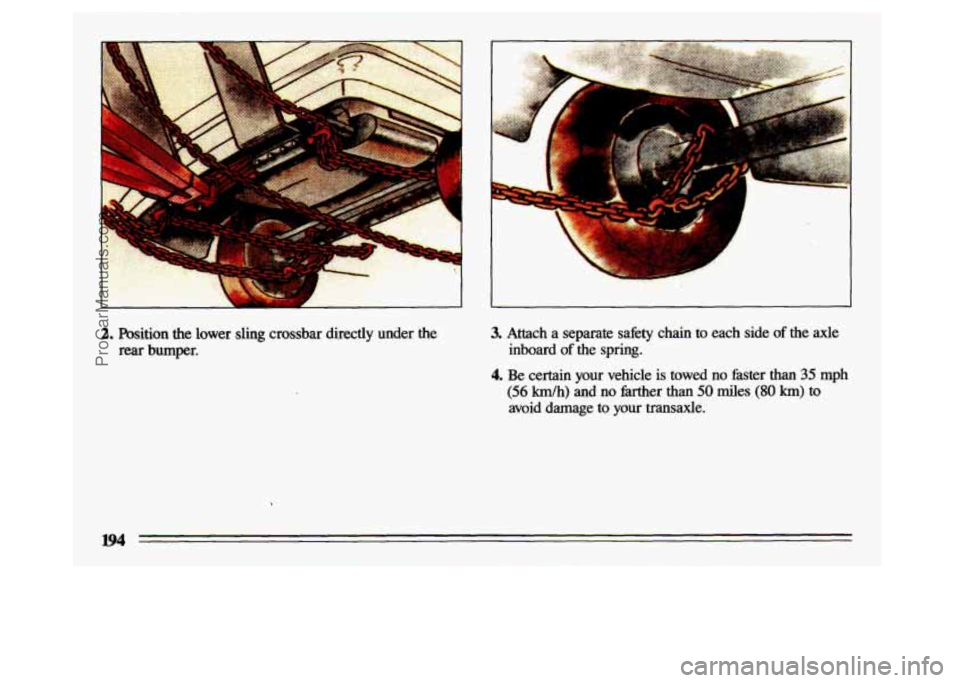
3. Attach a separate safety chain to each side of the axle
inboard of the spring.
4. Be certain your vehicle is towed no faster than 35 mph
(56 Wh) and no mer than 50 miles (80 km) to
avoid damage to your transaxle.
ProCarManuals.com
Page 197 of 324
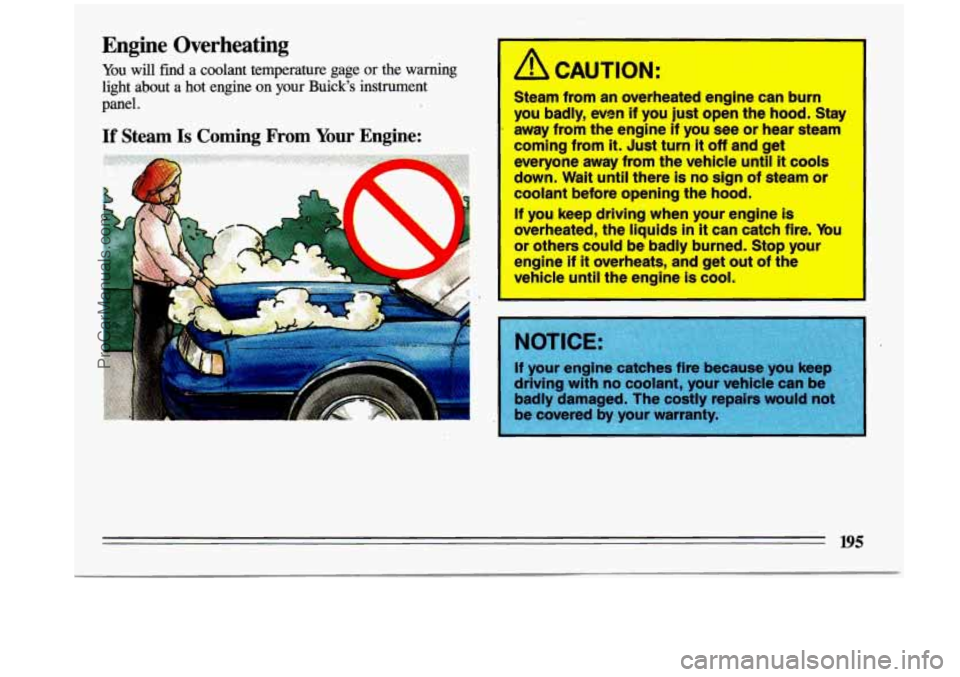
Engine Overheating
You will find a coolant temperature gage or the warning
light about a hot engine on your Buick’s instrument panel. A CAUTION:
Steam from an overheated engine can burn
you badly, even if you
just open the hood. Stay
away from the engine if you see
or hear steam
coming from
it. Just turn it off and get
everyone away from the vehicle until
it cools
down. Wait
until there is no sign of steam or
coolant before opening the hood.
If you keep driving when your engine is
overheated, the liquids
in it can catch fire. You -w others could be badly burned. Stop your
~gine if
it overheats, and get out of the
vehicle until the engine is cool.
195
ProCarManuals.com
Page 198 of 324
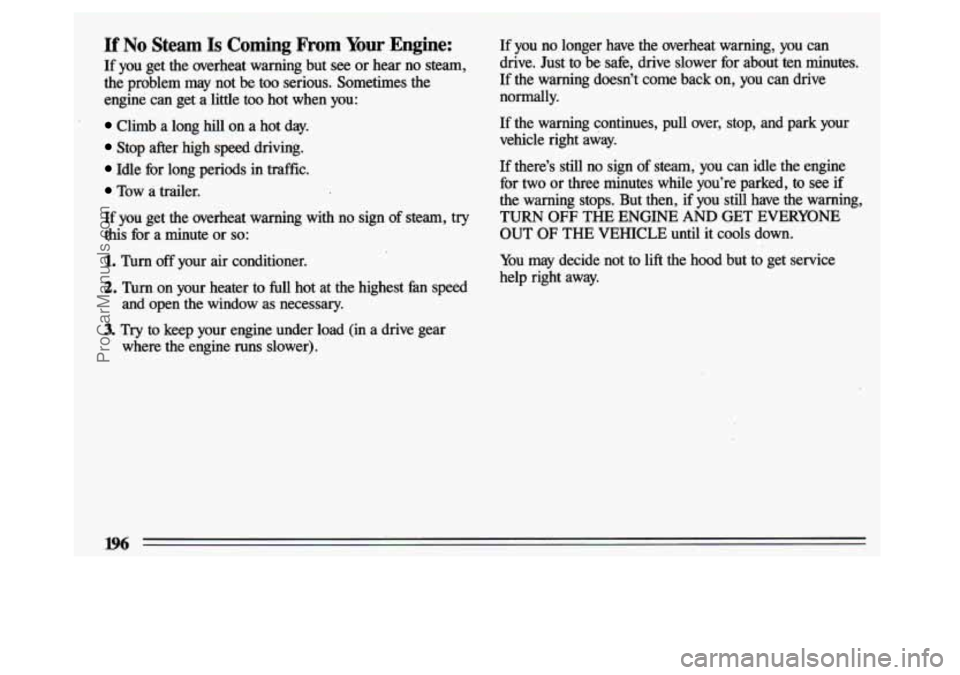
If No Steam Is Coming From Your-Engine:
If you get the overheat warning but see or hear no steam,
the problem
may not be too serious. Sometimes the
engine can get a little too hot when you:
Climb a long hill on a hot day.
Stop after high speed driving.
Idle for long periods in traffic.
Tow a trailer.
If you get the overheat warning with
no sign of steam, try
this for a minute or so:
1. Turn off your air conditioner.
2. Turn on your heater to full hot at the highest fan speed
and open the window as necessary.
3. Try to keep your engine under load (in a drive gear
where the engine runs slower). If you no longer have the overheat warning, you can
drive. Just to be safe, drive slower for about ten minutes.
If the warning doesn’t come back on, you can drive
normally.
If the warning continues, pull over, stop, and park your
vehicle right away.
If there’s still no sign of steam, you can idle the engine\
for two or three minutes while you’re parked, to
see if
the warning stops. But then, if you still have the warning,
TURN OFF THE ENGRVE AND GET EVERYONE
OUT
OF THE VEHICLE until it cools down.
You may decide
not to lift the hood but to get service
help right away.
ProCarManuals.com
Page 199 of 324
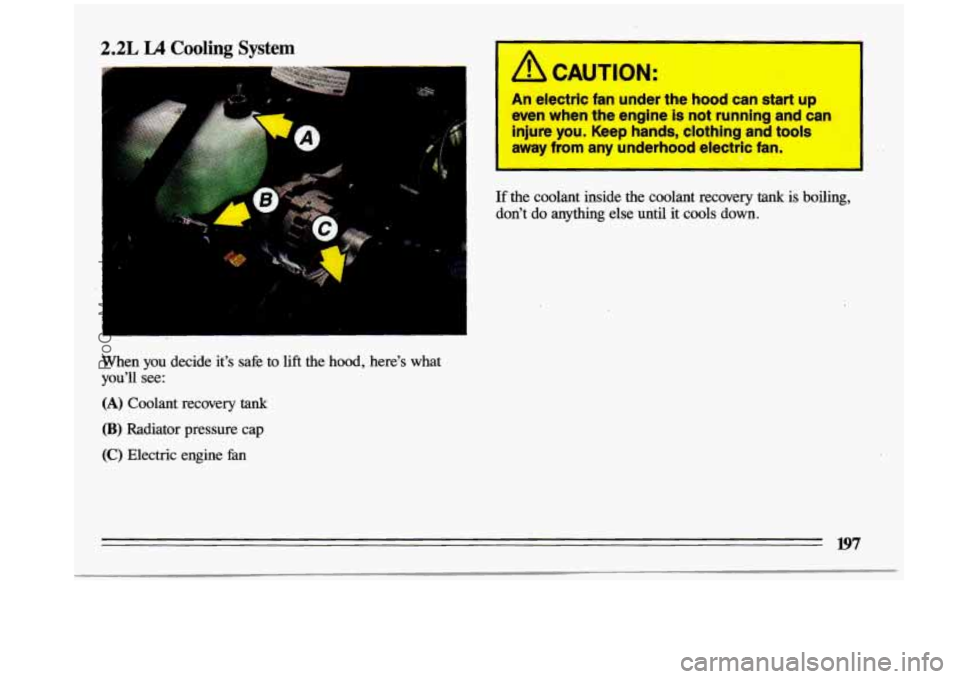
2.2L L4 Cooling System
=
1
When you decide it’s safe to lift the hood, here’s what
you’ll
see:
(A) Coolant recovery tank
(B) Radiator pressure cap
(C) Electric engine fan
It!, CAUTION:
An electric fan under the hood can start up
even when the engine is not running and can
injure you. Keep hands, clothing and tools
away from any underhood electric fan.
If the coolant inside the coolant recovery tank is boiling,
don’t do anything else until it cools down.
ProCarManuals.com
Page 200 of 324
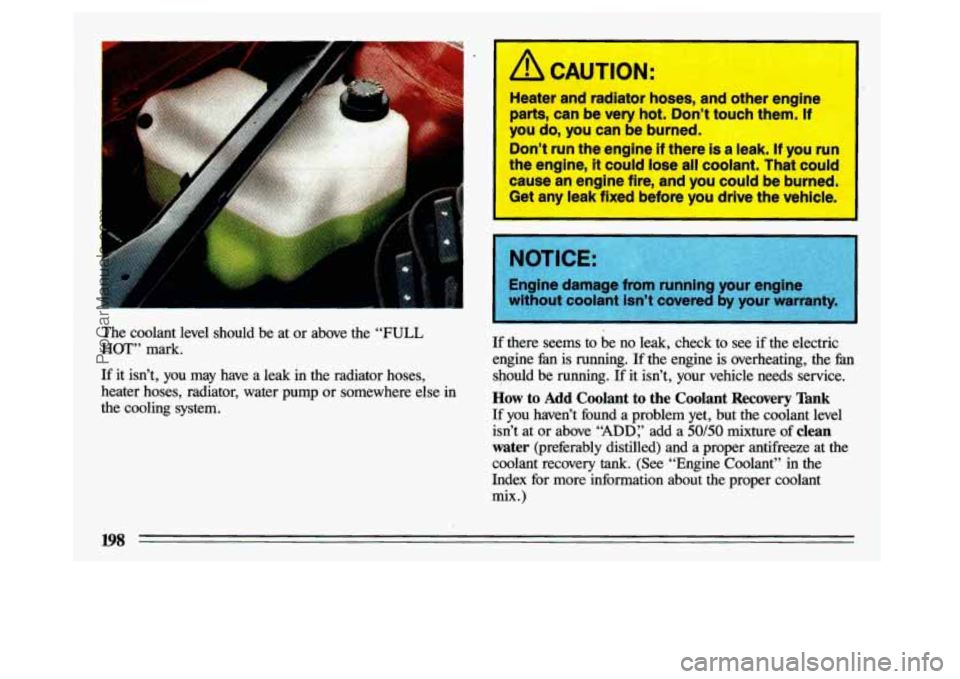
I
The coolant level should be at or above the “FULL
HOT” mark.
If it isn’t, you may have a leak in the radiator hoses,
heater hoses, radiator, water pump or somewhere else in
the cooling system.
1 [ CAUTION:
Heater and radiator hoses, and other engine
parts, can be very
hot. Don’t touch them. If
you
do, you can be burned.
Don’t run the engine if there
is a leak. If you run
the engine,
it could lose all coolant. That could
cause an engine fire, and you could be burned.
Get any leak fixed before you drive the vehicle.
If there seems to be no leak, check to see if the electric
engine
f8n is running. If the engine is overheating, the f8n
should be running. If it isn’t, your vehicle needs service. \
How to Add Coolant to the Coolant Recovery lhnk
If you haven’t found a problem yet, but the coolant level
isn’t at or above
“ADD:’ add a 50/50 mixture of clean
water (preferably distilled) and a proper antifreeze at the
coolant recovery
tank. (See “Engine Coolant” in the
Index for more information about the proper coolant
mix.)
i
I98
ProCarManuals.com